Understanding the Rohingya Crisis: A Case Study of Myanmar/Burma
VerifiedAdded on 2023/06/14
|7
|1630
|222
Case Study
AI Summary
This case study provides an overview of the Rohingya crisis in Myanmar, examining the historical context, the reasons behind the name change from Burma to Myanmar, and the factors leading to the emergence of the crisis. It highlights the long-standing conflict between the Rohingya Muslim minority and the ethnic Buddhist communities, exacerbated by the denial of citizenship to the Rohingya. The study identifies early warning signals, such as the age-old conflict and the discovery of mass graves, and discusses the nations affected, including Bangladesh and India, due to the influx of refugees. It also assesses the international response, the impact of diplomacy, and the roles of various international bodies and nations. Finally, the case study recommends steps to resolve the crisis, including pressurizing the Myanmar government, promoting accountability in the United Nations, and offering support and assistance.
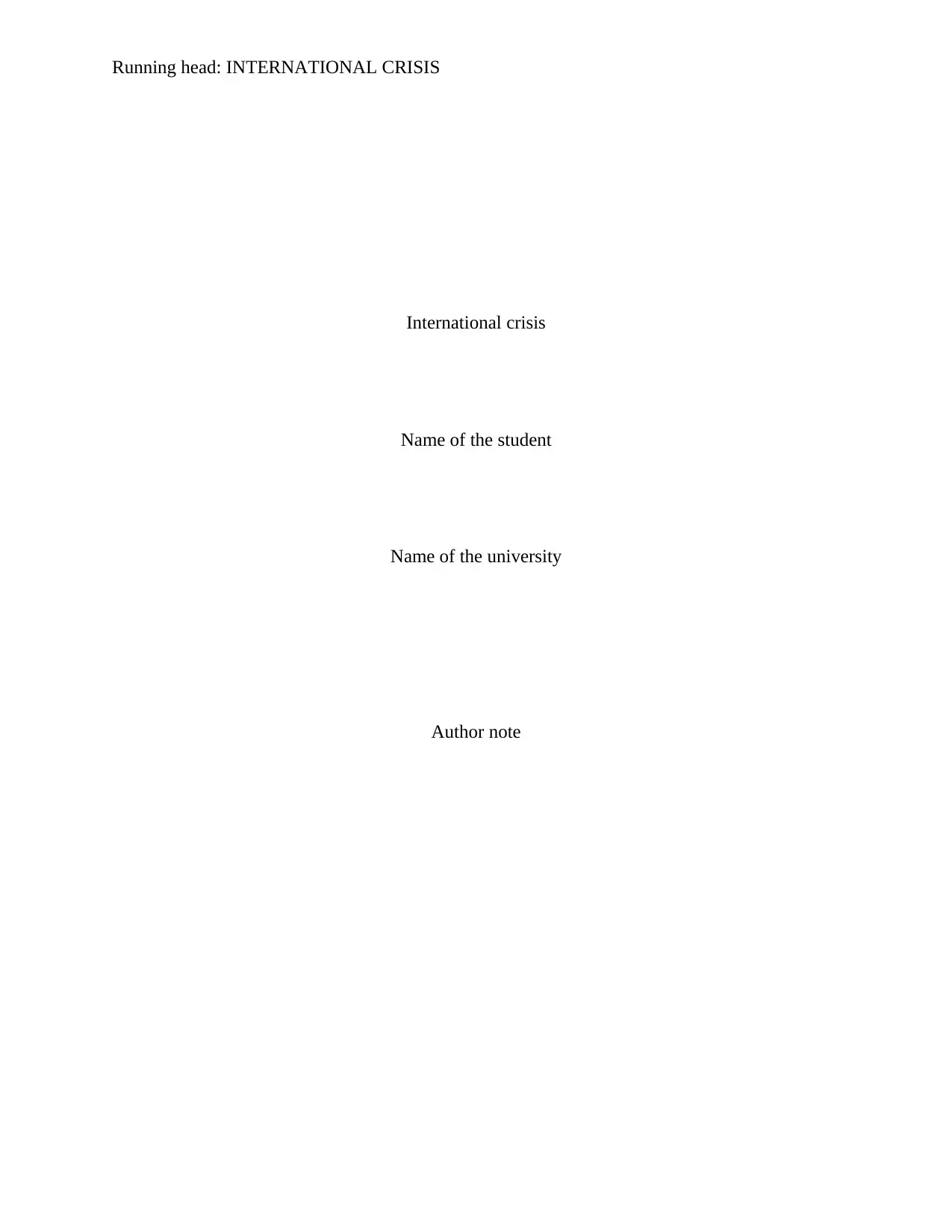
Running head: INTERNATIONAL CRISIS
International crisis
Name of the student
Name of the university
Author note
International crisis
Name of the student
Name of the university
Author note
Paraphrase This Document
Need a fresh take? Get an instant paraphrase of this document with our AI Paraphraser
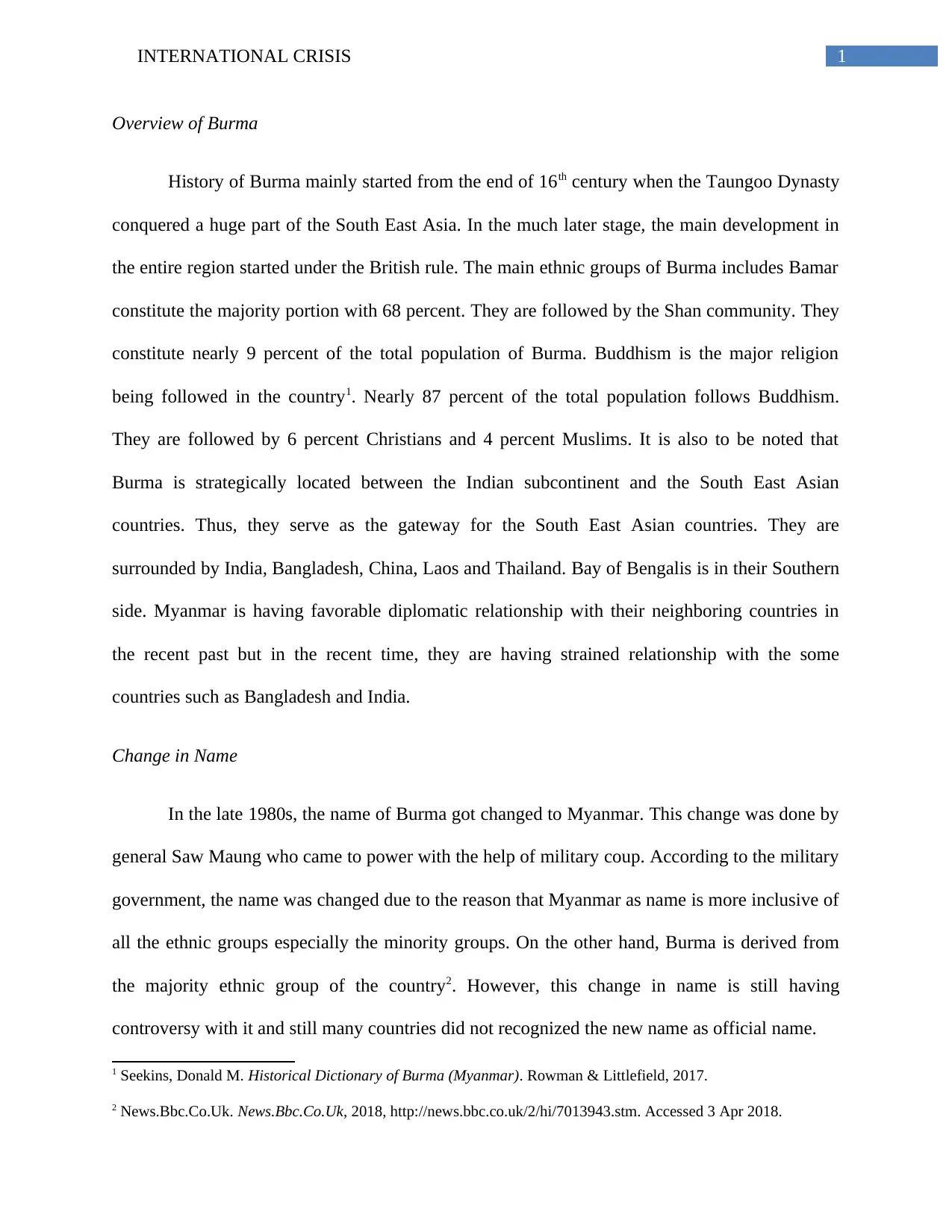
1INTERNATIONAL CRISIS
Overview of Burma
History of Burma mainly started from the end of 16th century when the Taungoo Dynasty
conquered a huge part of the South East Asia. In the much later stage, the main development in
the entire region started under the British rule. The main ethnic groups of Burma includes Bamar
constitute the majority portion with 68 percent. They are followed by the Shan community. They
constitute nearly 9 percent of the total population of Burma. Buddhism is the major religion
being followed in the country1. Nearly 87 percent of the total population follows Buddhism.
They are followed by 6 percent Christians and 4 percent Muslims. It is also to be noted that
Burma is strategically located between the Indian subcontinent and the South East Asian
countries. Thus, they serve as the gateway for the South East Asian countries. They are
surrounded by India, Bangladesh, China, Laos and Thailand. Bay of Bengalis is in their Southern
side. Myanmar is having favorable diplomatic relationship with their neighboring countries in
the recent past but in the recent time, they are having strained relationship with the some
countries such as Bangladesh and India.
Change in Name
In the late 1980s, the name of Burma got changed to Myanmar. This change was done by
general Saw Maung who came to power with the help of military coup. According to the military
government, the name was changed due to the reason that Myanmar as name is more inclusive of
all the ethnic groups especially the minority groups. On the other hand, Burma is derived from
the majority ethnic group of the country2. However, this change in name is still having
controversy with it and still many countries did not recognized the new name as official name.
1 Seekins, Donald M. Historical Dictionary of Burma (Myanmar). Rowman & Littlefield, 2017.
2 News.Bbc.Co.Uk. News.Bbc.Co.Uk, 2018, http://news.bbc.co.uk/2/hi/7013943.stm. Accessed 3 Apr 2018.
Overview of Burma
History of Burma mainly started from the end of 16th century when the Taungoo Dynasty
conquered a huge part of the South East Asia. In the much later stage, the main development in
the entire region started under the British rule. The main ethnic groups of Burma includes Bamar
constitute the majority portion with 68 percent. They are followed by the Shan community. They
constitute nearly 9 percent of the total population of Burma. Buddhism is the major religion
being followed in the country1. Nearly 87 percent of the total population follows Buddhism.
They are followed by 6 percent Christians and 4 percent Muslims. It is also to be noted that
Burma is strategically located between the Indian subcontinent and the South East Asian
countries. Thus, they serve as the gateway for the South East Asian countries. They are
surrounded by India, Bangladesh, China, Laos and Thailand. Bay of Bengalis is in their Southern
side. Myanmar is having favorable diplomatic relationship with their neighboring countries in
the recent past but in the recent time, they are having strained relationship with the some
countries such as Bangladesh and India.
Change in Name
In the late 1980s, the name of Burma got changed to Myanmar. This change was done by
general Saw Maung who came to power with the help of military coup. According to the military
government, the name was changed due to the reason that Myanmar as name is more inclusive of
all the ethnic groups especially the minority groups. On the other hand, Burma is derived from
the majority ethnic group of the country2. However, this change in name is still having
controversy with it and still many countries did not recognized the new name as official name.
1 Seekins, Donald M. Historical Dictionary of Burma (Myanmar). Rowman & Littlefield, 2017.
2 News.Bbc.Co.Uk. News.Bbc.Co.Uk, 2018, http://news.bbc.co.uk/2/hi/7013943.stm. Accessed 3 Apr 2018.
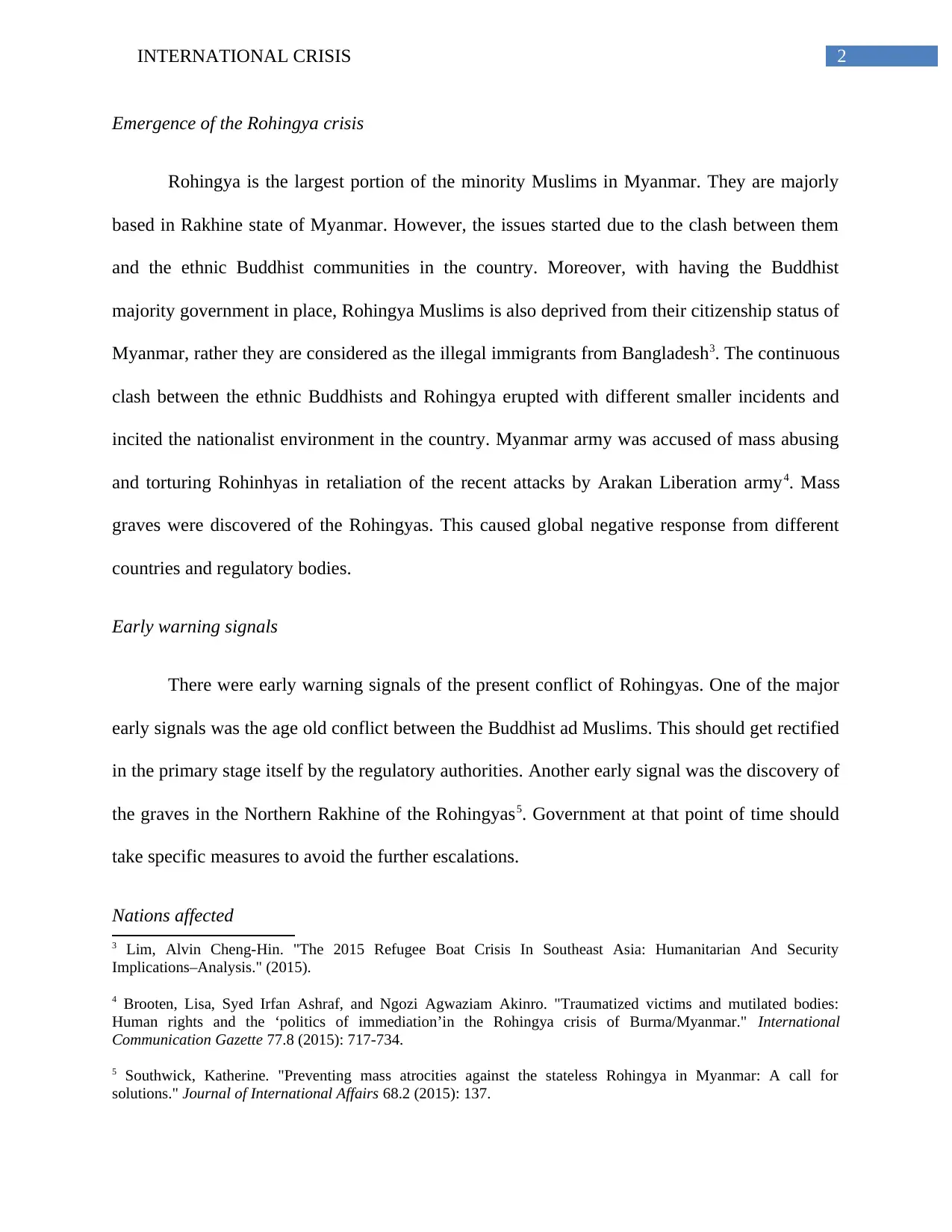
2INTERNATIONAL CRISIS
Emergence of the Rohingya crisis
Rohingya is the largest portion of the minority Muslims in Myanmar. They are majorly
based in Rakhine state of Myanmar. However, the issues started due to the clash between them
and the ethnic Buddhist communities in the country. Moreover, with having the Buddhist
majority government in place, Rohingya Muslims is also deprived from their citizenship status of
Myanmar, rather they are considered as the illegal immigrants from Bangladesh3. The continuous
clash between the ethnic Buddhists and Rohingya erupted with different smaller incidents and
incited the nationalist environment in the country. Myanmar army was accused of mass abusing
and torturing Rohinhyas in retaliation of the recent attacks by Arakan Liberation army4. Mass
graves were discovered of the Rohingyas. This caused global negative response from different
countries and regulatory bodies.
Early warning signals
There were early warning signals of the present conflict of Rohingyas. One of the major
early signals was the age old conflict between the Buddhist ad Muslims. This should get rectified
in the primary stage itself by the regulatory authorities. Another early signal was the discovery of
the graves in the Northern Rakhine of the Rohingyas5. Government at that point of time should
take specific measures to avoid the further escalations.
Nations affected
3 Lim, Alvin Cheng-Hin. "The 2015 Refugee Boat Crisis In Southeast Asia: Humanitarian And Security
Implications–Analysis." (2015).
4 Brooten, Lisa, Syed Irfan Ashraf, and Ngozi Agwaziam Akinro. "Traumatized victims and mutilated bodies:
Human rights and the ‘politics of immediation’in the Rohingya crisis of Burma/Myanmar." International
Communication Gazette 77.8 (2015): 717-734.
5 Southwick, Katherine. "Preventing mass atrocities against the stateless Rohingya in Myanmar: A call for
solutions." Journal of International Affairs 68.2 (2015): 137.
Emergence of the Rohingya crisis
Rohingya is the largest portion of the minority Muslims in Myanmar. They are majorly
based in Rakhine state of Myanmar. However, the issues started due to the clash between them
and the ethnic Buddhist communities in the country. Moreover, with having the Buddhist
majority government in place, Rohingya Muslims is also deprived from their citizenship status of
Myanmar, rather they are considered as the illegal immigrants from Bangladesh3. The continuous
clash between the ethnic Buddhists and Rohingya erupted with different smaller incidents and
incited the nationalist environment in the country. Myanmar army was accused of mass abusing
and torturing Rohinhyas in retaliation of the recent attacks by Arakan Liberation army4. Mass
graves were discovered of the Rohingyas. This caused global negative response from different
countries and regulatory bodies.
Early warning signals
There were early warning signals of the present conflict of Rohingyas. One of the major
early signals was the age old conflict between the Buddhist ad Muslims. This should get rectified
in the primary stage itself by the regulatory authorities. Another early signal was the discovery of
the graves in the Northern Rakhine of the Rohingyas5. Government at that point of time should
take specific measures to avoid the further escalations.
Nations affected
3 Lim, Alvin Cheng-Hin. "The 2015 Refugee Boat Crisis In Southeast Asia: Humanitarian And Security
Implications–Analysis." (2015).
4 Brooten, Lisa, Syed Irfan Ashraf, and Ngozi Agwaziam Akinro. "Traumatized victims and mutilated bodies:
Human rights and the ‘politics of immediation’in the Rohingya crisis of Burma/Myanmar." International
Communication Gazette 77.8 (2015): 717-734.
5 Southwick, Katherine. "Preventing mass atrocities against the stateless Rohingya in Myanmar: A call for
solutions." Journal of International Affairs 68.2 (2015): 137.
⊘ This is a preview!⊘
Do you want full access?
Subscribe today to unlock all pages.

Trusted by 1+ million students worldwide
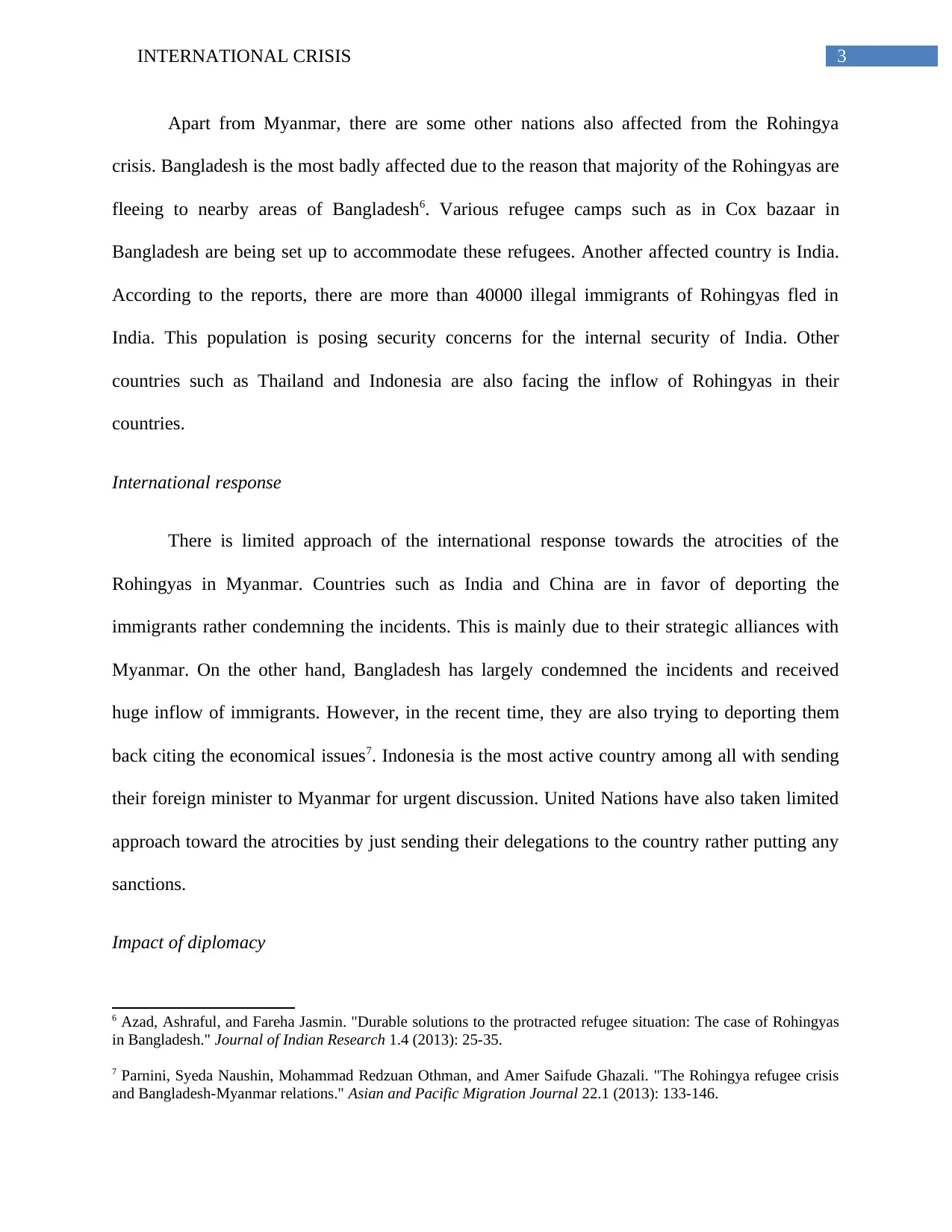
3INTERNATIONAL CRISIS
Apart from Myanmar, there are some other nations also affected from the Rohingya
crisis. Bangladesh is the most badly affected due to the reason that majority of the Rohingyas are
fleeing to nearby areas of Bangladesh6. Various refugee camps such as in Cox bazaar in
Bangladesh are being set up to accommodate these refugees. Another affected country is India.
According to the reports, there are more than 40000 illegal immigrants of Rohingyas fled in
India. This population is posing security concerns for the internal security of India. Other
countries such as Thailand and Indonesia are also facing the inflow of Rohingyas in their
countries.
International response
There is limited approach of the international response towards the atrocities of the
Rohingyas in Myanmar. Countries such as India and China are in favor of deporting the
immigrants rather condemning the incidents. This is mainly due to their strategic alliances with
Myanmar. On the other hand, Bangladesh has largely condemned the incidents and received
huge inflow of immigrants. However, in the recent time, they are also trying to deporting them
back citing the economical issues7. Indonesia is the most active country among all with sending
their foreign minister to Myanmar for urgent discussion. United Nations have also taken limited
approach toward the atrocities by just sending their delegations to the country rather putting any
sanctions.
Impact of diplomacy
6 Azad, Ashraful, and Fareha Jasmin. "Durable solutions to the protracted refugee situation: The case of Rohingyas
in Bangladesh." Journal of Indian Research 1.4 (2013): 25-35.
7 Parnini, Syeda Naushin, Mohammad Redzuan Othman, and Amer Saifude Ghazali. "The Rohingya refugee crisis
and Bangladesh-Myanmar relations." Asian and Pacific Migration Journal 22.1 (2013): 133-146.
Apart from Myanmar, there are some other nations also affected from the Rohingya
crisis. Bangladesh is the most badly affected due to the reason that majority of the Rohingyas are
fleeing to nearby areas of Bangladesh6. Various refugee camps such as in Cox bazaar in
Bangladesh are being set up to accommodate these refugees. Another affected country is India.
According to the reports, there are more than 40000 illegal immigrants of Rohingyas fled in
India. This population is posing security concerns for the internal security of India. Other
countries such as Thailand and Indonesia are also facing the inflow of Rohingyas in their
countries.
International response
There is limited approach of the international response towards the atrocities of the
Rohingyas in Myanmar. Countries such as India and China are in favor of deporting the
immigrants rather condemning the incidents. This is mainly due to their strategic alliances with
Myanmar. On the other hand, Bangladesh has largely condemned the incidents and received
huge inflow of immigrants. However, in the recent time, they are also trying to deporting them
back citing the economical issues7. Indonesia is the most active country among all with sending
their foreign minister to Myanmar for urgent discussion. United Nations have also taken limited
approach toward the atrocities by just sending their delegations to the country rather putting any
sanctions.
Impact of diplomacy
6 Azad, Ashraful, and Fareha Jasmin. "Durable solutions to the protracted refugee situation: The case of Rohingyas
in Bangladesh." Journal of Indian Research 1.4 (2013): 25-35.
7 Parnini, Syeda Naushin, Mohammad Redzuan Othman, and Amer Saifude Ghazali. "The Rohingya refugee crisis
and Bangladesh-Myanmar relations." Asian and Pacific Migration Journal 22.1 (2013): 133-146.
Paraphrase This Document
Need a fresh take? Get an instant paraphrase of this document with our AI Paraphraser
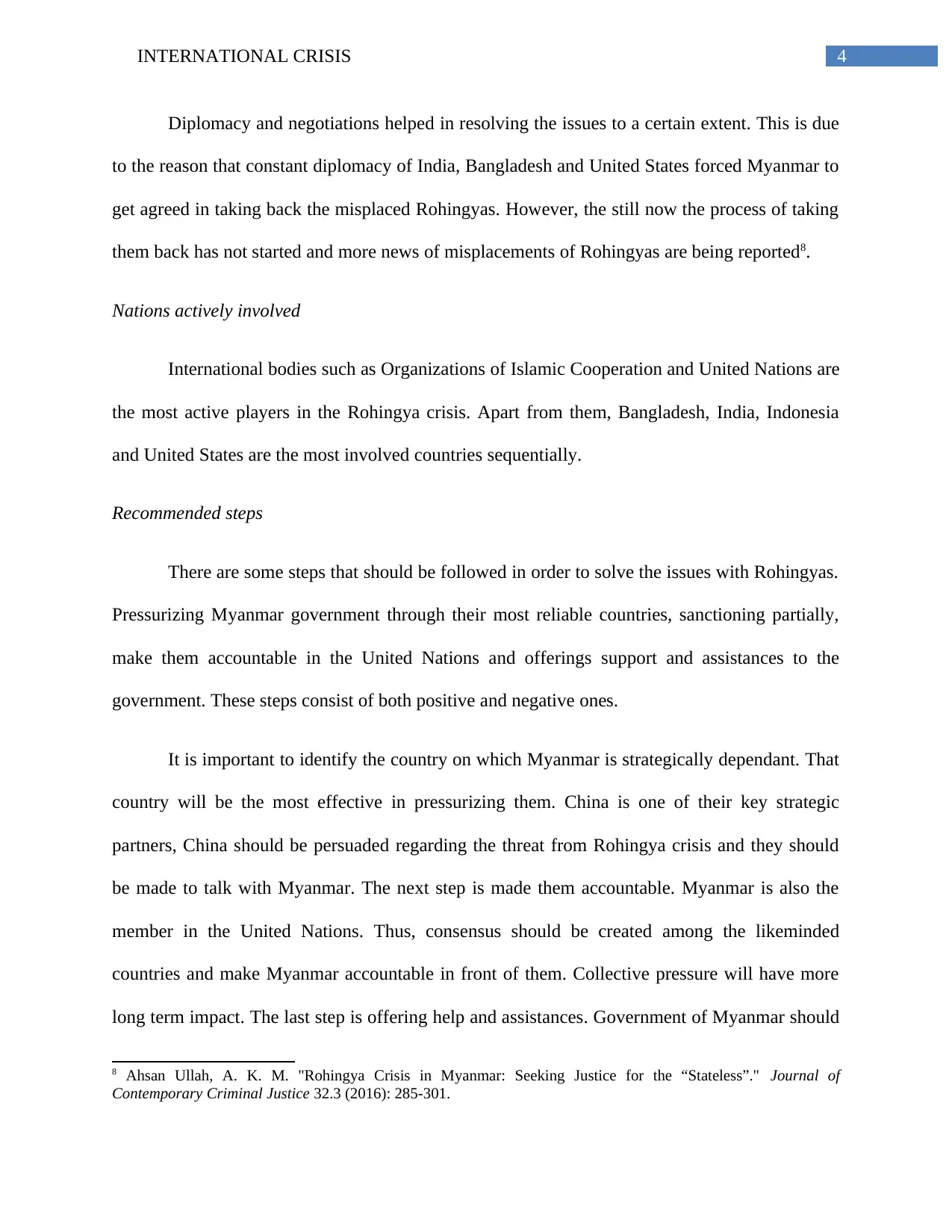
4INTERNATIONAL CRISIS
Diplomacy and negotiations helped in resolving the issues to a certain extent. This is due
to the reason that constant diplomacy of India, Bangladesh and United States forced Myanmar to
get agreed in taking back the misplaced Rohingyas. However, the still now the process of taking
them back has not started and more news of misplacements of Rohingyas are being reported8.
Nations actively involved
International bodies such as Organizations of Islamic Cooperation and United Nations are
the most active players in the Rohingya crisis. Apart from them, Bangladesh, India, Indonesia
and United States are the most involved countries sequentially.
Recommended steps
There are some steps that should be followed in order to solve the issues with Rohingyas.
Pressurizing Myanmar government through their most reliable countries, sanctioning partially,
make them accountable in the United Nations and offerings support and assistances to the
government. These steps consist of both positive and negative ones.
It is important to identify the country on which Myanmar is strategically dependant. That
country will be the most effective in pressurizing them. China is one of their key strategic
partners, China should be persuaded regarding the threat from Rohingya crisis and they should
be made to talk with Myanmar. The next step is made them accountable. Myanmar is also the
member in the United Nations. Thus, consensus should be created among the likeminded
countries and make Myanmar accountable in front of them. Collective pressure will have more
long term impact. The last step is offering help and assistances. Government of Myanmar should
8 Ahsan Ullah, A. K. M. "Rohingya Crisis in Myanmar: Seeking Justice for the “Stateless”." Journal of
Contemporary Criminal Justice 32.3 (2016): 285-301.
Diplomacy and negotiations helped in resolving the issues to a certain extent. This is due
to the reason that constant diplomacy of India, Bangladesh and United States forced Myanmar to
get agreed in taking back the misplaced Rohingyas. However, the still now the process of taking
them back has not started and more news of misplacements of Rohingyas are being reported8.
Nations actively involved
International bodies such as Organizations of Islamic Cooperation and United Nations are
the most active players in the Rohingya crisis. Apart from them, Bangladesh, India, Indonesia
and United States are the most involved countries sequentially.
Recommended steps
There are some steps that should be followed in order to solve the issues with Rohingyas.
Pressurizing Myanmar government through their most reliable countries, sanctioning partially,
make them accountable in the United Nations and offerings support and assistances to the
government. These steps consist of both positive and negative ones.
It is important to identify the country on which Myanmar is strategically dependant. That
country will be the most effective in pressurizing them. China is one of their key strategic
partners, China should be persuaded regarding the threat from Rohingya crisis and they should
be made to talk with Myanmar. The next step is made them accountable. Myanmar is also the
member in the United Nations. Thus, consensus should be created among the likeminded
countries and make Myanmar accountable in front of them. Collective pressure will have more
long term impact. The last step is offering help and assistances. Government of Myanmar should
8 Ahsan Ullah, A. K. M. "Rohingya Crisis in Myanmar: Seeking Justice for the “Stateless”." Journal of
Contemporary Criminal Justice 32.3 (2016): 285-301.
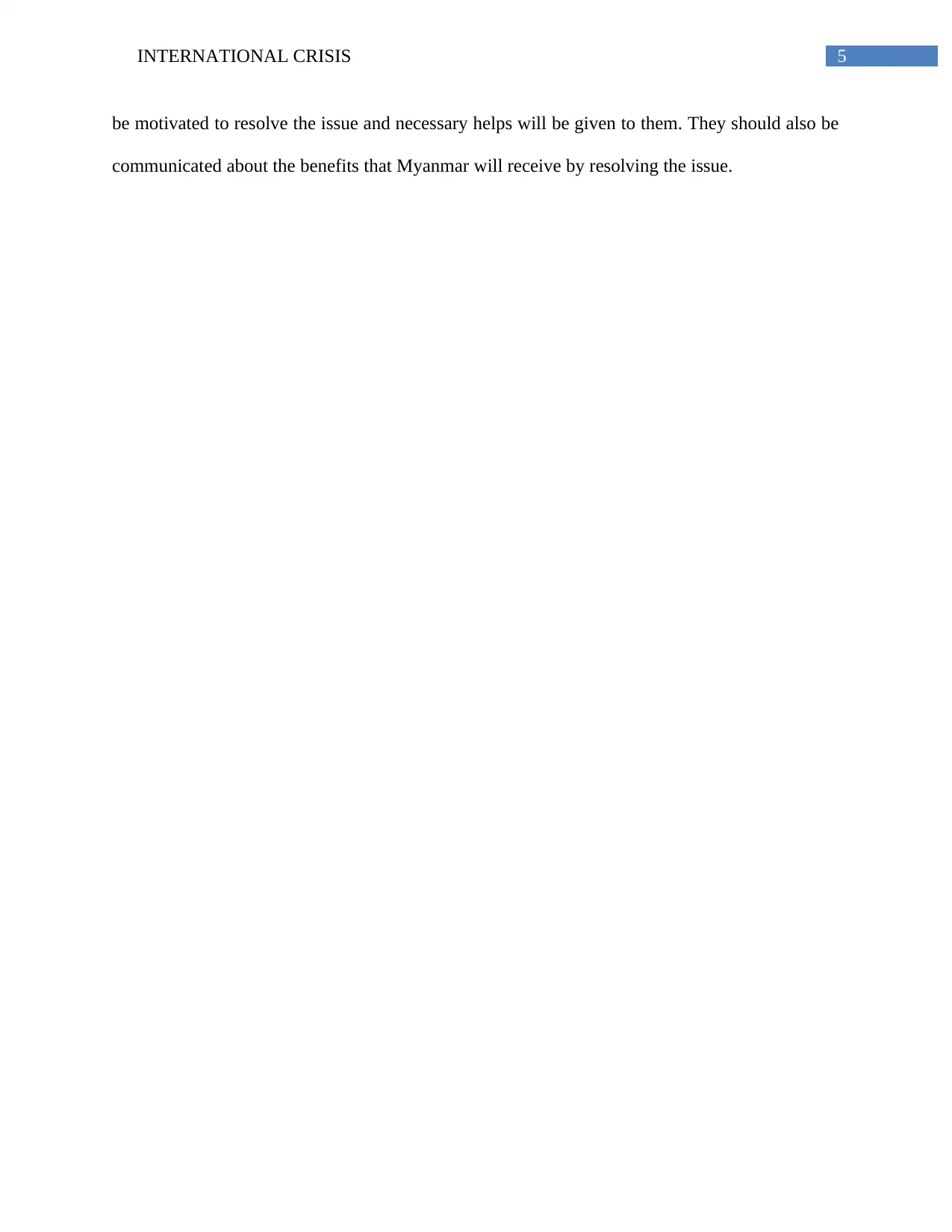
5INTERNATIONAL CRISIS
be motivated to resolve the issue and necessary helps will be given to them. They should also be
communicated about the benefits that Myanmar will receive by resolving the issue.
be motivated to resolve the issue and necessary helps will be given to them. They should also be
communicated about the benefits that Myanmar will receive by resolving the issue.
⊘ This is a preview!⊘
Do you want full access?
Subscribe today to unlock all pages.

Trusted by 1+ million students worldwide
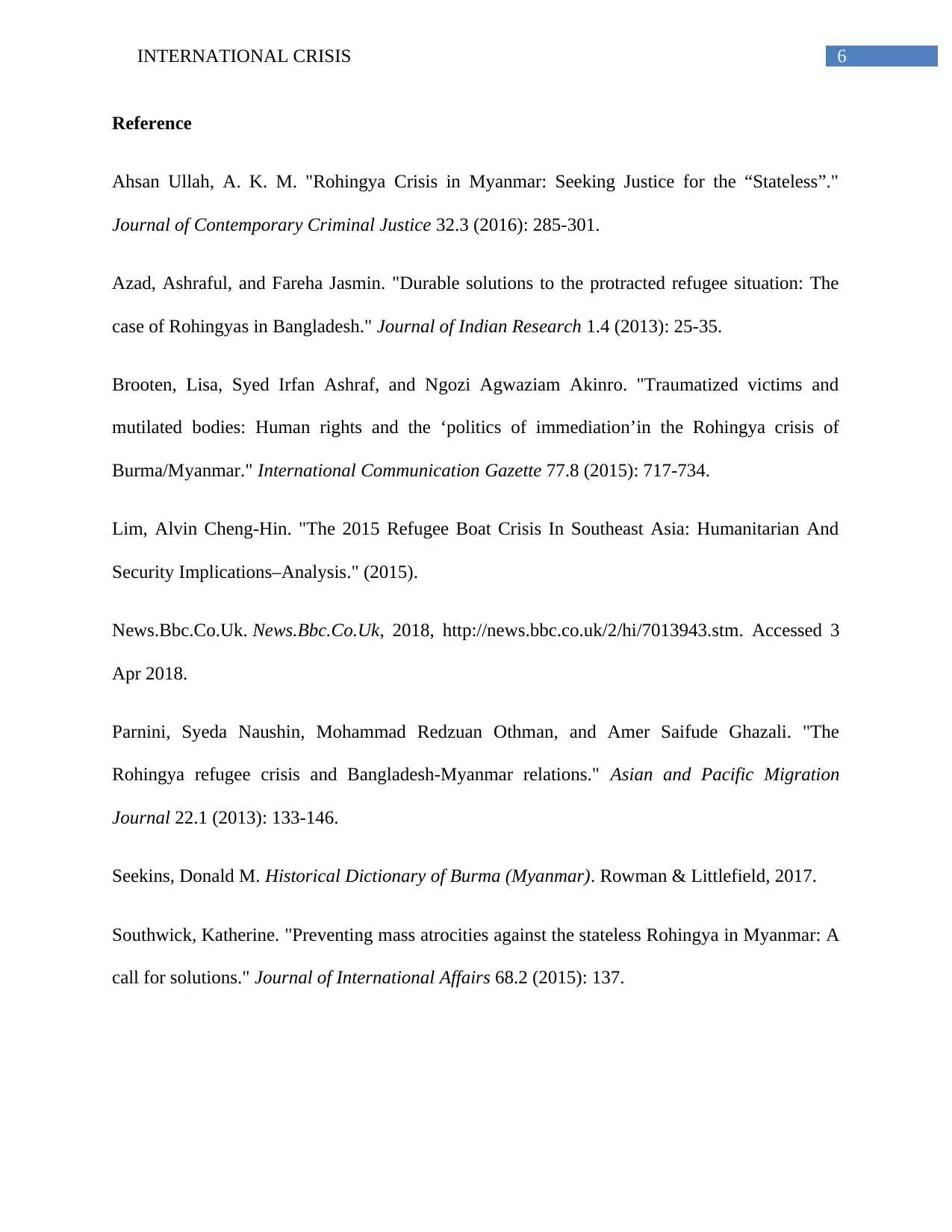
6INTERNATIONAL CRISIS
Reference
Ahsan Ullah, A. K. M. "Rohingya Crisis in Myanmar: Seeking Justice for the “Stateless”."
Journal of Contemporary Criminal Justice 32.3 (2016): 285-301.
Azad, Ashraful, and Fareha Jasmin. "Durable solutions to the protracted refugee situation: The
case of Rohingyas in Bangladesh." Journal of Indian Research 1.4 (2013): 25-35.
Brooten, Lisa, Syed Irfan Ashraf, and Ngozi Agwaziam Akinro. "Traumatized victims and
mutilated bodies: Human rights and the ‘politics of immediation’in the Rohingya crisis of
Burma/Myanmar." International Communication Gazette 77.8 (2015): 717-734.
Lim, Alvin Cheng-Hin. "The 2015 Refugee Boat Crisis In Southeast Asia: Humanitarian And
Security Implications–Analysis." (2015).
News.Bbc.Co.Uk. News.Bbc.Co.Uk, 2018, http://news.bbc.co.uk/2/hi/7013943.stm. Accessed 3
Apr 2018.
Parnini, Syeda Naushin, Mohammad Redzuan Othman, and Amer Saifude Ghazali. "The
Rohingya refugee crisis and Bangladesh-Myanmar relations." Asian and Pacific Migration
Journal 22.1 (2013): 133-146.
Seekins, Donald M. Historical Dictionary of Burma (Myanmar). Rowman & Littlefield, 2017.
Southwick, Katherine. "Preventing mass atrocities against the stateless Rohingya in Myanmar: A
call for solutions." Journal of International Affairs 68.2 (2015): 137.
Reference
Ahsan Ullah, A. K. M. "Rohingya Crisis in Myanmar: Seeking Justice for the “Stateless”."
Journal of Contemporary Criminal Justice 32.3 (2016): 285-301.
Azad, Ashraful, and Fareha Jasmin. "Durable solutions to the protracted refugee situation: The
case of Rohingyas in Bangladesh." Journal of Indian Research 1.4 (2013): 25-35.
Brooten, Lisa, Syed Irfan Ashraf, and Ngozi Agwaziam Akinro. "Traumatized victims and
mutilated bodies: Human rights and the ‘politics of immediation’in the Rohingya crisis of
Burma/Myanmar." International Communication Gazette 77.8 (2015): 717-734.
Lim, Alvin Cheng-Hin. "The 2015 Refugee Boat Crisis In Southeast Asia: Humanitarian And
Security Implications–Analysis." (2015).
News.Bbc.Co.Uk. News.Bbc.Co.Uk, 2018, http://news.bbc.co.uk/2/hi/7013943.stm. Accessed 3
Apr 2018.
Parnini, Syeda Naushin, Mohammad Redzuan Othman, and Amer Saifude Ghazali. "The
Rohingya refugee crisis and Bangladesh-Myanmar relations." Asian and Pacific Migration
Journal 22.1 (2013): 133-146.
Seekins, Donald M. Historical Dictionary of Burma (Myanmar). Rowman & Littlefield, 2017.
Southwick, Katherine. "Preventing mass atrocities against the stateless Rohingya in Myanmar: A
call for solutions." Journal of International Affairs 68.2 (2015): 137.
1 out of 7
Related Documents
Your All-in-One AI-Powered Toolkit for Academic Success.
+13062052269
info@desklib.com
Available 24*7 on WhatsApp / Email
![[object Object]](/_next/static/media/star-bottom.7253800d.svg)
Unlock your academic potential
Copyright © 2020–2025 A2Z Services. All Rights Reserved. Developed and managed by ZUCOL.





